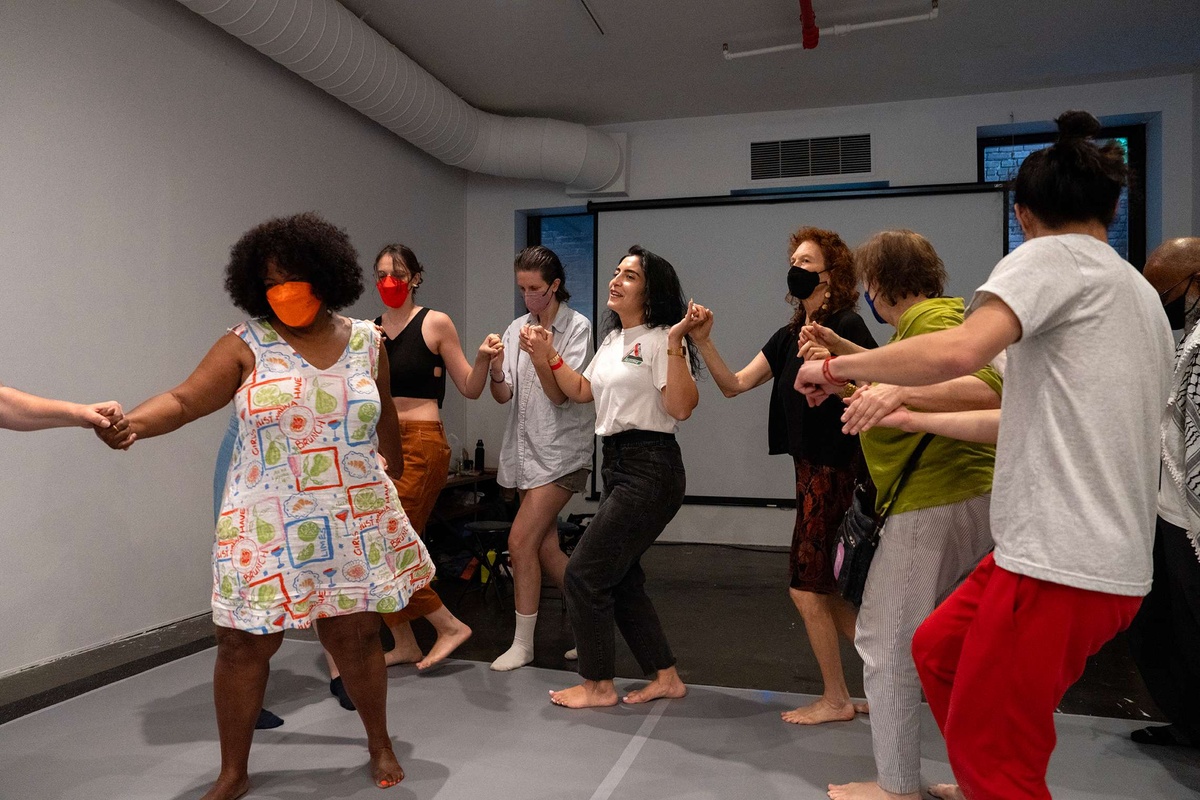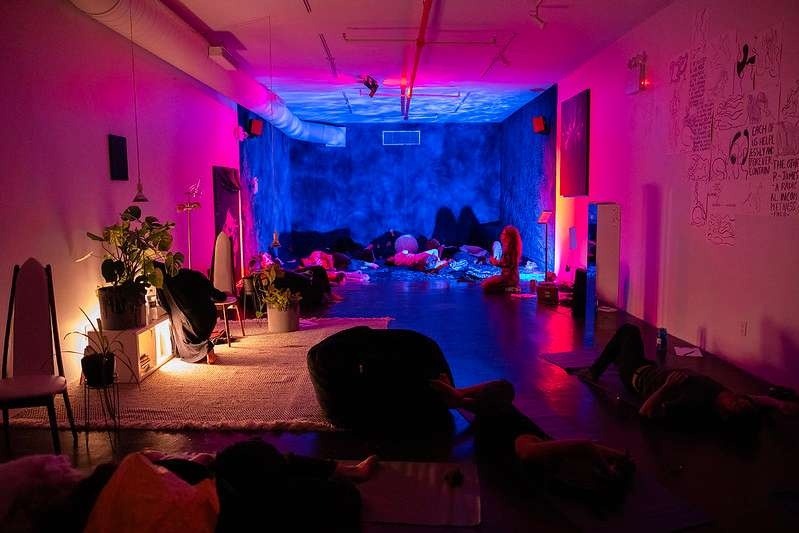A History of Black American Beauty and a Meditation on the Beauty Supply
Brooklyn White
The beauty supply store is ubiquitous in Black life. Inside, people’s half-braided scalps complement eyes surveying packs of waved hair. The material crinkles in the hand of a woman serving as her own beautician. Mothers squint at a relaxer they’ve used since they were 8 years old; the packaging is skewing toward younger consumers, rendering it nearly unrecognizable. “Is this it?” one asks aloud to no one. (It is.) You’ll hear hearty laughs, the kind that curl at the ends, from manicured teenagers clutching packs of mink lashes that will flutter at beaus. There is a communion here.
Dana Davenport’s 2021 Session project Dana’s Beauty Supply at Recess was a recreation of the beauty supply store. With wooden shelves holding gel, hair lotions, packs of hair, edge control, wigs, and various self care items, Davenport sought to create a relaxing environment for people to have their beauty needs met. The artist also includes copies of Beauty Times, a Korean magazine typically only found in actual stores. In one issue, a brown-skinned Black woman with a kinky weave gently smiles for the cover shot, her face surrounded by Korean text.
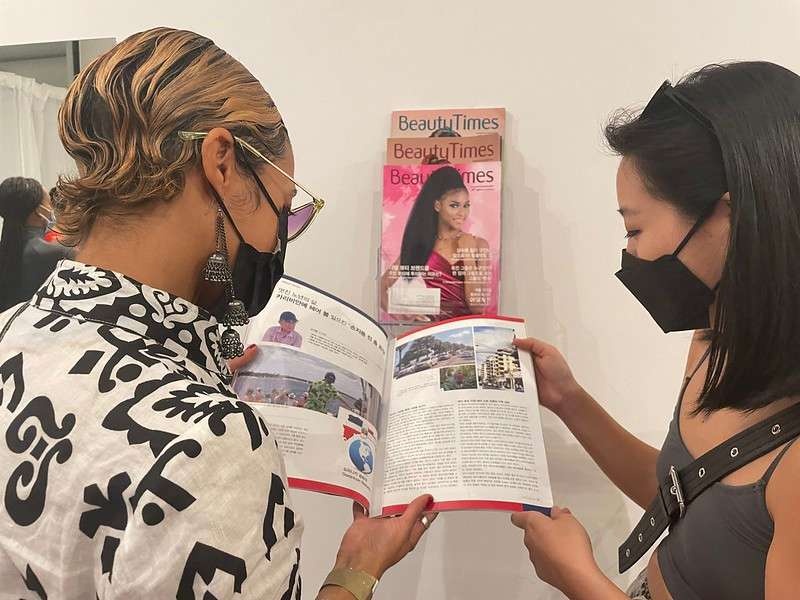

Gallery visitors reading Beauty Times
From Louisiana to New York, my mother and I have shuffled to the small shops like the one Davenport recreates—shops with at least one glass wall and all of the beauty balms one could need. My grandmother and my daughter have walked the thin aisles as well, one looking on with a knowing gaze, the other in wonder. A deep interest in beauty is generational—just last night my daughter asked me to swipe a dull orange, vegan lipstick across her lips. In America, a Black person’s kempt look is two-fold. On one hand, it reflects a sense of pride and a declaration of self-concern. On the other hand, Black people’s efforts to look a Eurocentric version of their best is a reflection of the many demands of racism. Where locked hair is a marker of commitment and braids are a direct tie to ancestral styles, both are viciously scrutinized in white supremacist workplaces.
The origin of Black American beauty practices is connected to some of the earliest days of church. In 1835’s “The South-West: By a Yankee,” author Joseph Holt Ingraham spoke about the lengths enslaved Africans in Mississippi would go to to present their best selves to their Higher Power. “In every cabin the men are shaving and dressing—the women, arrayed in their gay muslin, are arranging their frizzy hair in which they take no little pride, or investigating the condition of their children’s heads—the old people neatly clothed are quietly conversing or smoking about their doors,” he wrote. With personal appearance also being inextricably linked to spiritual upkeep, it was only a matter of time before an industry built around Black beauty was erected. The presence of the Black community’s ongoing concern with upkeep made space for financial gain. From Madame CJ Walker’s pioneering company and Josephine Baker’s branding partnerships to Naomi Sims’ Black hair-inspired Kanekalon® wigs, it seemed that a path to getting a piece of the pie was being blazed. That is, until they began to be shut out of the beauty supply industry.
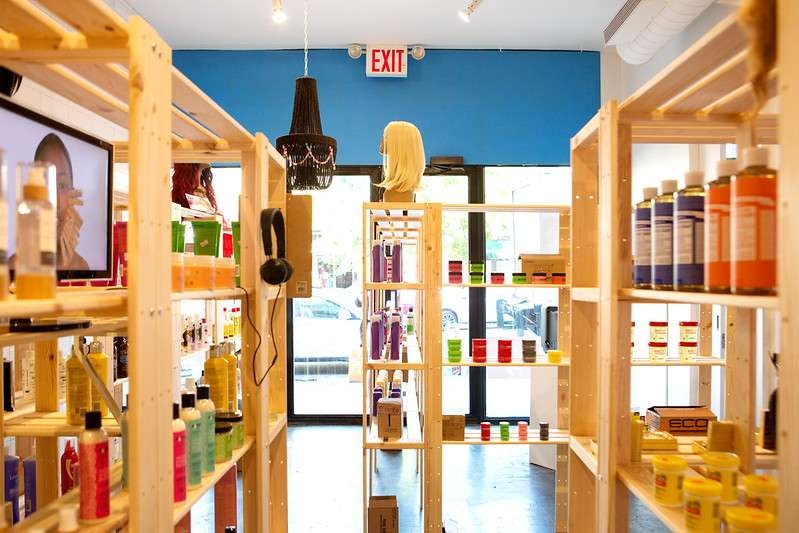

Photo by Mary Kang
For a 2008 issue of Ebony, Adrienne Samuels explained that Korean beauty stores began to pop up in urban areas in the 1970s. They started small: selling wigs and then more malleable hair types (extensions and braiding hair) before growing into offering a slew of Black hair products of all kinds, including natural hair creams, relaxers, tools, and more. It was just a means to an end, as the community needed to make money after just under 15,000 Koreans immigrated to the U.S. following the Korean War. The stores that were built were passed down through families for generations and even though Black people were spending billions of dollars and what feels like unlimited time in these stores, they weren’t exactly being offered a seat at the table. The strain has since become increasingly apparent.
In 2017, Karen Coffey, the owner of a then-new beauty supply store, claimed that some Korean hair vendors refused to sell her products. In 2021, Atlanta’s Charis McWhorter and Dana Hawkins revealed they’ve been fighting a similar battle, saying “So once we got into the industry, that’s when we started learning more about how they try to keep us out by not giving us certain accounts, [certain suppliers] would deny us for no particular reason…And we will try to place orders, however, the supplier would tell us they’re out of stock. But the stores up the street are getting their products by the box loads.” There is a certain white hot pain that comes with being good enough to have a cash cow built on your back without consistently being welcomed to the lucrative side of things.
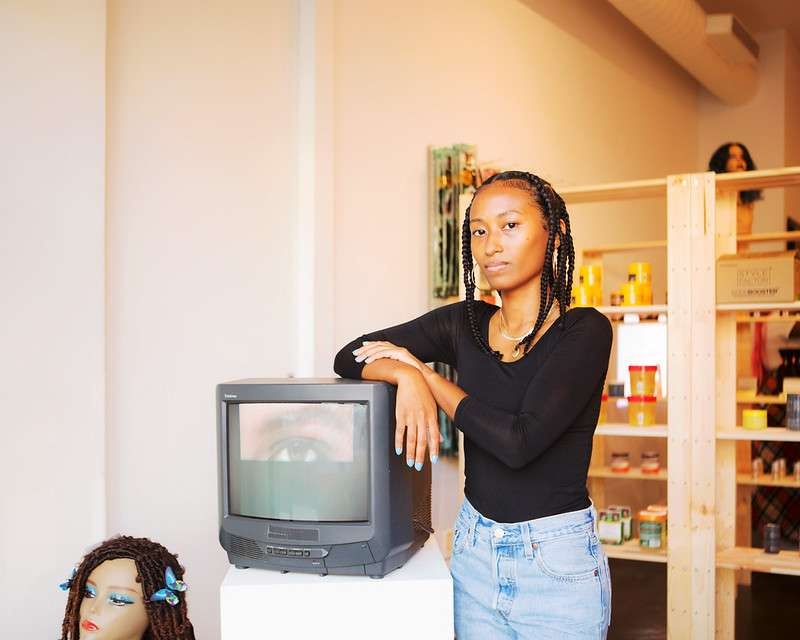

Photo by Mary Kang
Black consumers have also discussed being followed by owners in-store and being treated as suspicious. Beauty spaces overall are hubs for chronic anti-Blackness—in 2021, a Sally Beauty Supply employee admitted to asking co-workers to follow Black customers. The discomfort sits on the outermost layer of skin like a taffeta sleeve. People know when they are not wanted. They know when they are being shooed away like children by ever-busy parents. They feel when they are someone’s paying nuisance. Targeted exclusion is hell-hot coals in the hands.
With the Black community spending nine times more on beauty materials than non-Black counterparts, and beauty supply stores being focused on Black customers, beauty spaces must have anti-racism baked into the core of their ventures. Not to take advantage of the ever-growing emphasis on improving one’s body, but for the safety and comfort of Black consumers who have an innate, bone-deep beauty. Black people must be able to enjoy their time in a store, as well as their work to build their own. For centuries, it has been a duty to adorn heart and flesh, even amidst our darkest hours. With the summer 2020 onus on police brutality and alarming instances of AAPI violence mounting, we must ask if the external violence and earnest need for alliance will quell some of the discontent. Store owners deserve an environment that is quaint and beneficial, regular customers and those looking to enter the service side should be entitled to genuine assistance.
Davenport’s Recess Session project explored the Black joy associated with the beauty supply while highlighting the agitation between merchandisers and consumers. Traditionally, questions about racism are left to linger in the back of one’s mind, but rarely, if ever, are they confronted in an actual store. She also worked with Paris Beauty Supplyz, a Black owned beauty store in Brooklyn, New York, allowing them to handle the curation.
Starting with the profits from the store, Davenport is also looking to support the next generation of Black people in the beauty industry by creating a scholarship fund for those looking to obtain their cosmetology license. With no lack of inspiration or talent in sight, many young people are cropped out of the process simply because they are unable to afford it. With an ally on their side, and one who is uniquely aware of the struggles the community faces, she feels it will help further facilitate change for those seeking to enter the business once and for all.
Citations
[1] “The South-West: By a Yankee,” Joseph Holt Ingraham, (1835)
[2] “Guess Who Sells Your Weave,” EBONY, Adrienne P. Samuels (2008)
[3] “Koreans’ Immigration To The U.S: History and Contemporary Trends,” Pyong Gap Min Queens College and the Graduate Center of CUNY (2011)
[4] “Roots of Tension: Race, Hair, Competition, and Black Beauty Stores, Emma Sapong, MPR News, (2017)
[5] “Two Business Owners Survive Racism and Other Barriers to Open Beauty Supply Store,” The Atlanta Voice, Itoro Umontuen, (2021).
[6] “Sally Beauty Supply Employs Manager Who Admitted to Racial Profiling and Signaled Employees When African Americans Enter the Store, According to Lawsuit Filed by ILG Legal Office,” PR Newswire, (2021)
About the artist
Brooklyn White
Brooklyn White is a writer and and editor. She made history as the first person to hold the title of Gen Z editor, and oversees Girls United, ESSENCE’s platform for young Black women.
Explore/Archive
See allJanuary 2026
Freedom Time Meditation: Cartographies of Release
Neta Bomani
Artist and educator Neta Bomani offers a guided meditation on FREEDOM TIME: Undanced Dances Through Prison Walls
December 2025
The INSTITUTE FOR TRANSHUMANIST CEPHALOPOD EVOLUTION and Learning from Octopuses
Barbara London
Barbara London reflect's of Miriam SImun's INSTITUTE FOR TRANSHUMANIST CEPHALOPOD EVOLUTION
October 2025
streamlined reflections, courtesy of noise canceling headphones
Gabrielle Rucker
Gabrielle Rucker reflects on the radical intimacy and auditory life at the heart of Deli Radio
